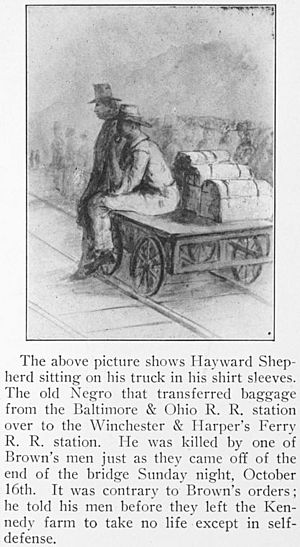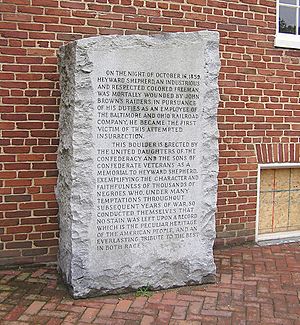Heyward Shepherd monument facts for kids
The Heyward Shepherd monument in Harpers Ferry, West Virginia, was built in 1931. It was put up by groups like the United Daughters of the Confederacy (UDC). The monument honors Heyward Shepherd (1825–1859), a free Black man. He was the first person killed during John Brown's raid on Harpers Ferry.
The monument was meant to share a certain idea: that enslaved people were happy and did not want to be free. This idea is part of what is called the Lost Cause. However, records show that many enslaved people were involved in John Brown's raid. Some were even seen with weapons. After the raid failed, some enslaved people said they were forced to be there. Their owners wanted to believe this story.
A different view comes from Osborne Perry Anderson. He was the only Black person with John Brown who escaped. He wrote that when they told enslaved people about their plan, there was "the greatest enthusiasm." He said an old woman prayed for their success. He also noted that enslaved people joined "without impressing or coaxing." This shows that many Black people wanted to be free and supported John Brown's actions.
However, official reports from Virginia leaders like Robert E. Lee and Governor Henry A. Wise claimed that no Black people joined willingly. Governor Wise's ideas were widely shared, even though he likely knew they were not true.
There is no proof that Heyward Shepherd was against ending slavery. It is also not known if he even knew about John Brown's plan. Still, the monument was built to challenge the idea that John Brown was a hero to Black people.
Caroline Janney, a historian, explains that the monument and the arguments around it show a rare time when Black and white memories of history openly clashed. The debate was about bigger ideas like slavery, race relations, and fighting against violence. By the 1930s, the debate was less about the facts of the raid or Shepherd's life. Instead, it became a fight over symbols. Shepherd became a symbol for the UDC, and Brown for the NAACP. They represented different ideas about how races should get along after slavery.
Contents
Who Was Heyward Shepherd?
Heyward Shepherd was a free Black man who lived in Winchester, Virginia. He lived along the Winchester and Potomac Railroad line. This was about 30 miles southwest of Harpers Ferry. He owned a small house and had a wife and five children. It is not clear if he was born free or was an enslaved person who gained freedom.
Shepherd worked for almost 20 years as a porter or baggage handler. He worked for the Baltimore and Ohio Railroad. Their trains traveled through Harpers Ferry. Harpers Ferry was the first place where two different train lines met. So, baggage often needed to be moved between the Baltimore and Ohio trains and the Winchester and Potomac Railroad trains.
The stationmaster in Harpers Ferry was Fontaine Beckham, who was also the mayor. When Beckham was away, Shepherd was in charge of the station. Beckham, who was also killed during the raid, "liked him very much."
Shepherd told a doctor what happened to him. He said he was on the railroad bridge looking for a missing watchman. Some men told him to stop. When he turned to go back to the office, they shot him in the back. The UDC later added to this story, saying he was trying to warn white people in Harpers Ferry. There is no proof for this part of the story.
Shepherd was buried in the Winchester–Fairfax Colored Cemetery. He was given public honors by the state of Virginia. His funeral was attended by soldiers. However, there is no marker on his grave.
Monuments and Plaques
For many years, there has been disagreement about what plaques should be placed near the UDC's monument. The Heyward Shepherd Memorial shows the struggle between white Southerners and African Americans. Both groups wanted to tell their own version of the raid's history.
John Brown's 1918 Plaque
The idea for the "faithful slave" monument came after a plaque honoring John Brown was put up. This plaque was placed on the "firehouse" building. This building had been moved to the campus of Storer College. The plaque reads:
THAT THIS NATION MIGHT HAVE
NEW BURST OF FREEDOM
THAT SLAVERY SHOULD BE REMOVED
FOREVER FROM AMERICAN SOIL
JOHN BROWN
AND HIS 21 MEN GAVE THEIR
LIVES
TO COMMEMORATE THEIR
HEROISM THIS TABLET IS
PLACED ON THIS BUILDING
WHICH HAS SINCE BEEN
KNOWN AS
JOHN BROWN'S FORT
BY THE
ALUMNI OF STORER COLLEGE
1918
The 1931 Heyward Shepherd Monument
In 1931, after many years of debate, the Heyward Shepherd monument was built. It was put up by the Sons of Confederate Veterans and the United Daughters of the Confederacy. The monument is made of granite and its text says:
On the night of October 16, 1859, Heyward Shepherd, an industrious and respected colored freeman, was mortally wounded by John Brown's raiders. In pursuance of his duties as an employee of the Baltimore and Ohio Railroad Company, he became the first victim of this attempted insurrection.
This boulder is erected by the United Daughters of the Confederacy and the Sons of Confederate Veterans as a memorial to Heyward Shepherd, exemplifying the character and faithfulness of thousands of negros who, under many temptations throughout subsequent years of war, so conducted themselves that no stain was left upon a record which is the peculiar heritage of the American people, and an everlasting tribute to the best in both races.
The 1932 NAACP Plaque
Many people immediately disagreed with the 1931 monument. They felt it supported the idea of the "faithful slave" to justify slavery.
The NAACP responded by creating their own plaque. It was meant to be displayed at Storer College in Harpers Ferry. This college was where the firehouse used by John Brown had been moved. The words on the plaque were written by W. E. B. Du Bois, a co-founder of the NAACP.
The college president, Henry T. MacDonald, refused to let the plaque be put up. But 74 years later, in 2006, the plaque was finally placed on the side of the firehouse. The firehouse had been moved closer to its original spot. The plaque reads:
HERE
JOHN BROWN
AIMED AT HUMAN SLAVERY
A BLOW
THAT WOKE A GUILTY NATION.
WITH HIM FOUGHT
SEVEN SLAVES AND SONS OF SLAVES.
OVER HIS CRUCIFIED CORPSE
MARCHED 200,000 BLACK SOLDIERS
AND 4,000,000 FREEDMEN
SINGING
"JOHN BROWN'S BODY LIES
A-MOULDERING IN THE GRAVE
BUT HIS SOUL GOES MARCHING ON!"
IN GRATITUDE THIS TABLET IS ERECTED
THE NATIONAL ASSOCIATION FOR THE
ADVANCEMENT OF COLORED PEOPLE
MAY 21, 1932
The 1955 National Park Service Plaque
In 1955, the National Park Service added a plaque to explain the 1931 monument. The text on this plaque said:
John Brown's raid on the armory at Harpers Ferry caused the death of four townspeople. One of those who died in the fighting was Heyward Shepherd, a railroad baggagemaster and a free black. Although the true identity of his assailant is uncertain, Shepherd soon became a symbol of the "faithful servant" among those who deplored Brown's action against the traditional southern way of life. The monument, placed here in 1931, reflects those traditional views.
The monument was stored away from 1976 to 1980. Then it was covered until 1995.
The 1994 National Park Service Plaque
Another plaque was put up near the 1931 monument by the National Park Service in 1994. This plaque also helped explain the monument's history. It reads:
On October 17, 1859, abolitionist John Brown attacked Harpers Ferry to launch a war against slavery. Heyward Shepherd, a free African-American railroad baggage master, was shot and killed by Brown's men shortly after midnight. Seventy-two years later, on October 10, 1931, a crowd estimated to 300 whites and 100 blacks gathered to unveil and dedicate the Shepherd Monument. During the ceremony, voices rose to praise and denounce the monument. Conceived around the turn of the century, the monument endured controversy. In 1905, the United Daughters of the Confederacy stated that erecting the monument would influence for good the present and coming generations, and prove that the people of the South who owned slaves valued and respected their good qualities as no one else ever did or will do.
Images for kids




